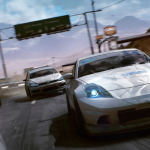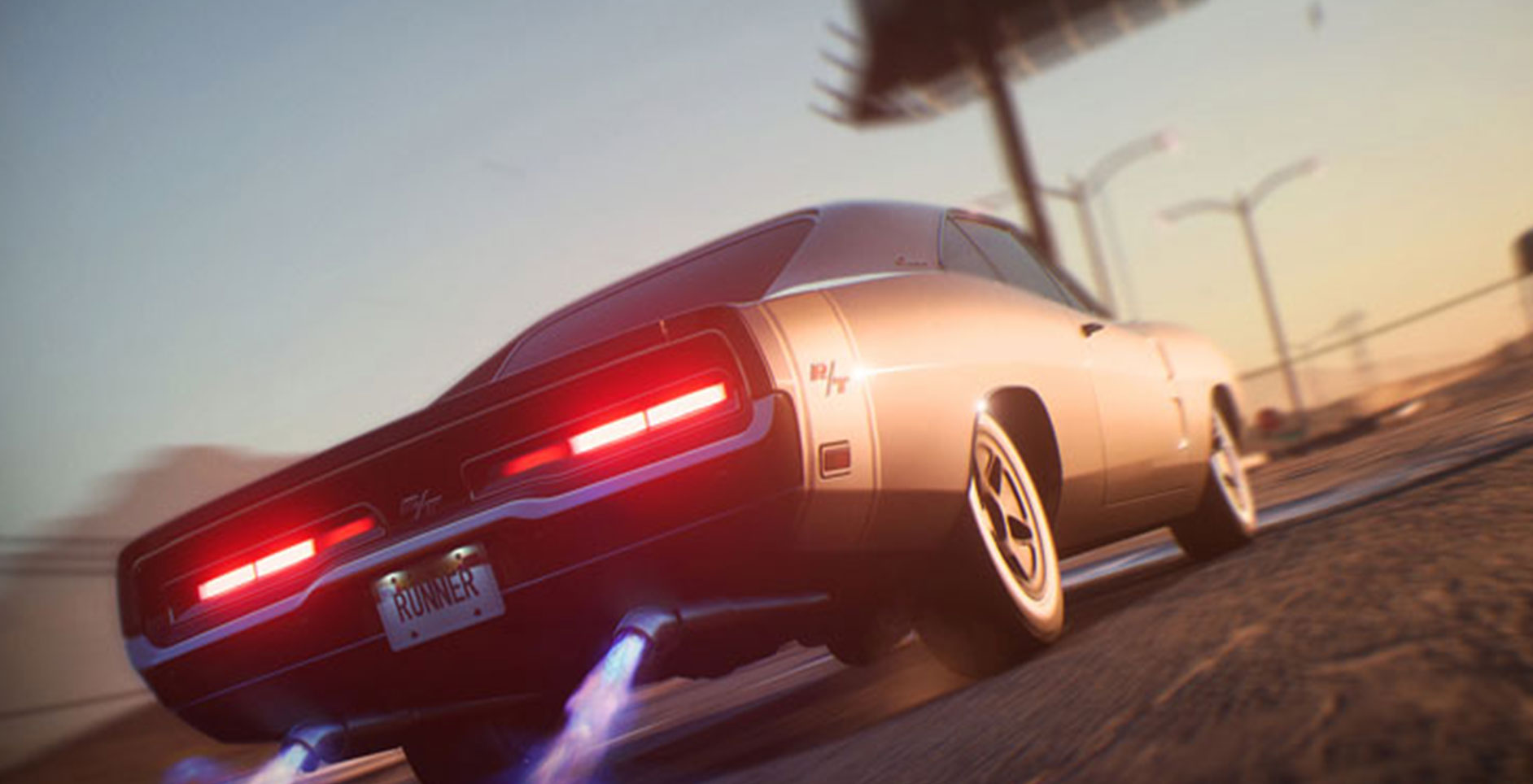For a game that prides itself on the thrill of the open road and larger-than-life set pieces, Need for Speed Payback still manages to be disappointingly lacklustre. From its generic narrative to its one-dimensional characters, the game’s shallow attempt at telling a nitrous-powered revenge story is only marginally saved by the game’s easily enjoyable style of accessible arcade racing.
This racing style perfectly complements Payback’s popcorn blockbuster motif but due to its lack of nuance, the gameplay eventually falls victim to the game’s imposed grind of repeating races in order to unlock and upgrade parts required to remain competitive against AI.  What’s easily most impressive about Payback is the scope of its open world. Set in the fictional US locale of Fortune Valley, the game’s vast and expansive landscape is a pleasure to traverse. From red laden dust bowls perfect for off-road racing to long sprawling urban streets that double as makeshift quarter miles for drag racing, the diverse scenery facilitates a world to race in that feels organic and varied. Unfortunately, the characters that inhabit this world lack the same kind of depth.
What’s easily most impressive about Payback is the scope of its open world. Set in the fictional US locale of Fortune Valley, the game’s vast and expansive landscape is a pleasure to traverse. From red laden dust bowls perfect for off-road racing to long sprawling urban streets that double as makeshift quarter miles for drag racing, the diverse scenery facilitates a world to race in that feels organic and varied. Unfortunately, the characters that inhabit this world lack the same kind of depth.
Payback has three playable protagonists that you rotate between in order to complete races and missions that specialise in their particular racing disciplines. Despite their differences behind the wheel, one thing they all have in common is wanting to get revenge on an associate of theirs who betrayed them during a heist. They quickly learn that their double-crossing partner works for ‘The House’ – a criminal group that controls everything in town (including the cops) and now their corruption is slowly spreading to street racing. As the name of the game suggests, the protagonists want payback and to disprove the notion that the “house always wins”. However, in order to do so, the crew must first earn its stripes around town by defeating a myriad of racing factions that call the streets of Fortune Valley home. Each faction represents a certain style of racing – with races ranging from your standard race, to off-road, to drag and finally drifting. There are also runner missions which generally consist of courier jobs or picking up a client that needs to lose the cops ASAP. Interspersed around the map with these races are also small challenges that can be completed for cash and rewards – these range from barrelling through billboards around the map to drift challenges. I didn’t find any of these side activities that entertaining and primarily stuck to the main mission races. The multitude of race types keep the gameplay loop of taking down factions fresh but they’re not without their shortcomings. The difference between regular and off-road races are negligible and drag racing literally consists of holding down accelerate while shifting gears whenever the speedometer says so. Some missions throw corrupt cops into the mix to try and take you out but the threat they pose is minimal. They’re rarely successful in their attempts to knock you off the road and will usually fly right by you or into a wall when trying to pin you to objects in the environment.
Each faction represents a certain style of racing – with races ranging from your standard race, to off-road, to drag and finally drifting. There are also runner missions which generally consist of courier jobs or picking up a client that needs to lose the cops ASAP. Interspersed around the map with these races are also small challenges that can be completed for cash and rewards – these range from barrelling through billboards around the map to drift challenges. I didn’t find any of these side activities that entertaining and primarily stuck to the main mission races. The multitude of race types keep the gameplay loop of taking down factions fresh but they’re not without their shortcomings. The difference between regular and off-road races are negligible and drag racing literally consists of holding down accelerate while shifting gears whenever the speedometer says so. Some missions throw corrupt cops into the mix to try and take you out but the threat they pose is minimal. They’re rarely successful in their attempts to knock you off the road and will usually fly right by you or into a wall when trying to pin you to objects in the environment.
As every race you partake in recommends your car to be at a particular level in order to be successful, the rewards you earn from racing and how you use them are essential. These rewards come in the form of money and ‘Speed Cards’. Instead of buying actual parts for your cars, each car has six slots in which the Speed Cards are used to fill. These cards represent various parts of the car (exhaust, turbo etc) and improve certain stats and the car’s level when implemented. If your car happens to have cards that all contain the same brand parts, it will get an added stats bonus.  Cards can be purchased both with in-game currency and real money and this is where the grind comes in. As certain types of cars can only be used for certain types of races, deciding when to purchase cards and cars can be an annoying thing to manage. There are a number of ways cards can be attained and none of them are really fun to do. For every race you win you get a card, if the card is of no use to you, you can trade it in for a what is called a part – when you have three parts, you can use them to operate a slot machine that rewards you with another card. Even with the majority of the game’s narrative taking place in a city reminiscent of Las Vegas, there was something about operating a pseudo slot machine for a new card that felt a little nefarious. Cards can also be bought from Tune-Up-Shops around the map but whether or not the shops have cards worth buying completely comes down to luck, as every thirty minutes the cards available change. As you require these cards to increase your car’s overall level, you will undoubtedly find yourself at some point in the game having to repeat previously completed missions in order to get the upgrades needed for the next race. With what has now sadly become the industry standard, this time consuming grinding can be alleviated with the help of microtransactions. Sometimes if I was marginally below the recommended level, I’d reduce the setting to easy as I really did not want to grind out a race I’d already done just to get my level up – checkmate Payback!
Cards can be purchased both with in-game currency and real money and this is where the grind comes in. As certain types of cars can only be used for certain types of races, deciding when to purchase cards and cars can be an annoying thing to manage. There are a number of ways cards can be attained and none of them are really fun to do. For every race you win you get a card, if the card is of no use to you, you can trade it in for a what is called a part – when you have three parts, you can use them to operate a slot machine that rewards you with another card. Even with the majority of the game’s narrative taking place in a city reminiscent of Las Vegas, there was something about operating a pseudo slot machine for a new card that felt a little nefarious. Cards can also be bought from Tune-Up-Shops around the map but whether or not the shops have cards worth buying completely comes down to luck, as every thirty minutes the cards available change. As you require these cards to increase your car’s overall level, you will undoubtedly find yourself at some point in the game having to repeat previously completed missions in order to get the upgrades needed for the next race. With what has now sadly become the industry standard, this time consuming grinding can be alleviated with the help of microtransactions. Sometimes if I was marginally below the recommended level, I’d reduce the setting to easy as I really did not want to grind out a race I’d already done just to get my level up – checkmate Payback!
Payback’s greatest misstep is its inability to capitalise on what makes car racing-centric stories fun. In particular, it fails to deliver when it comes to its large action packed set pieces and the dynamic between the characters at the forefront of these sequences. Instead, it takes itself way too seriously. The characters continuously deliver lines like “I’ll never complain as long I’m watching the sunset from behind the wheel” absolutely straightfaced. I get it man, you like racing, you don’t have to remind me every five minutes! When it comes to the game’s set pieces, it frustratingly takes control away from you whenever something cool is going to happen. In one scene, you have to pull up to a truck on the opposite side of the road so that one of the characters can get to a car that’s inside the truck. However, as soon as you get next to the truck, the game transitions to a cutscene. So instead of getting to be in the car as it explodes out of the back of the truck, you watch it all take place and are then given back control once the newly apprehended car is on the road. What should be a breathtaking set piece is instead reduced to a mission that is ultimately no different to any of the other driving sequences in the game.



